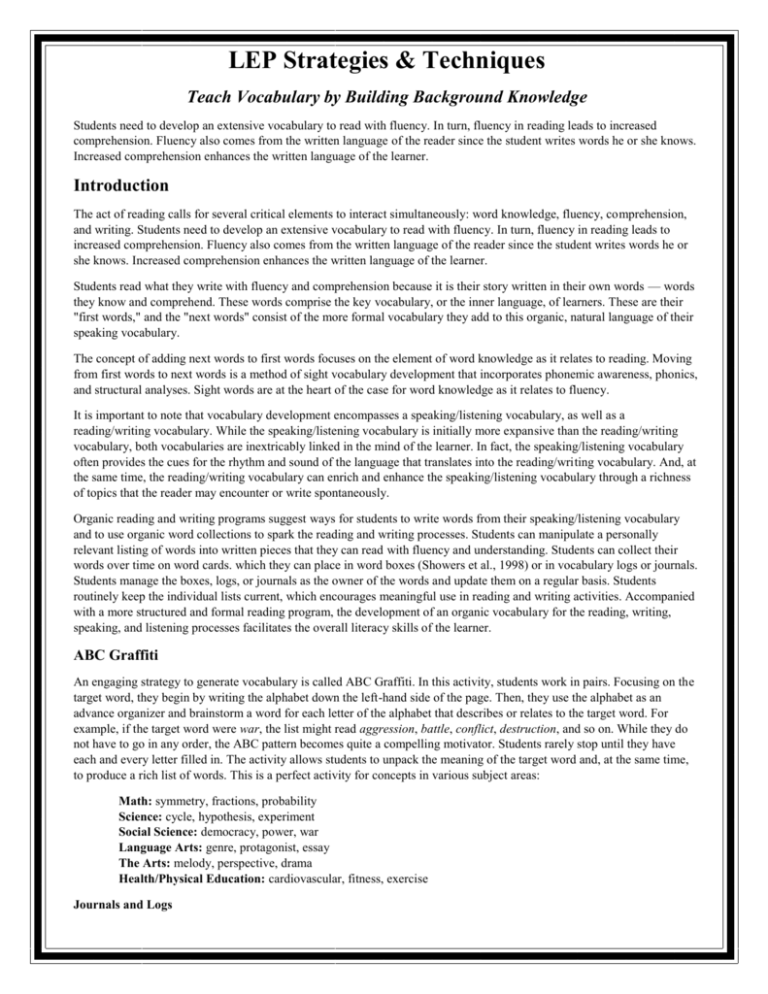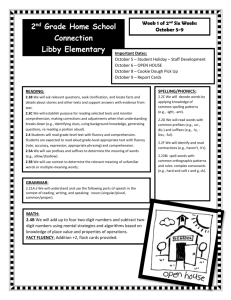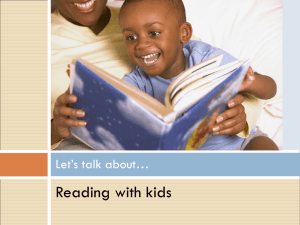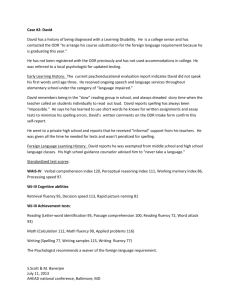LEP Strategies & Techniques Teach Vocabulary by Building
advertisement

LEP Strategies & Techniques Teach Vocabulary by Building Background Knowledge Students need to develop an extensive vocabulary to read with fluency. In turn, fluency in reading leads to increased comprehension. Fluency also comes from the written language of the reader since the student writes words he or she knows. Increased comprehension enhances the written language of the learner. Introduction The act of reading calls for several critical elements to interact simultaneously: word knowledge, fluency, comprehension, and writing. Students need to develop an extensive vocabulary to read with fluency. In turn, fluency in reading leads to increased comprehension. Fluency also comes from the written language of the reader since the student writes words he or she knows. Increased comprehension enhances the written language of the learner. Students read what they write with fluency and comprehension because it is their story written in their own words — words they know and comprehend. These words comprise the key vocabulary, or the inner language, of learners. These are their "first words," and the "next words" consist of the more formal vocabulary they add to this organic, natural language of their speaking vocabulary. The concept of adding next words to first words focuses on the element of word knowledge as it relates to reading. Moving from first words to next words is a method of sight vocabulary development that incorporates phonemic awareness, phonics, and structural analyses. Sight words are at the heart of the case for word knowledge as it relates to fluency. It is important to note that vocabulary development encompasses a speaking/listening vocabulary, as well as a reading/writing vocabulary. While the speaking/listening vocabulary is initially more expansive than the reading/writing vocabulary, both vocabularies are inextricably linked in the mind of the learner. In fact, the speaking/listening vocabulary often provides the cues for the rhythm and sound of the language that translates into the reading/writing vocabulary. And, at the same time, the reading/writing vocabulary can enrich and enhance the speaking/listening vocabulary through a richness of topics that the reader may encounter or write spontaneously. Organic reading and writing programs suggest ways for students to write words from their speaking/listening vocabulary and to use organic word collections to spark the reading and writing processes. Students can manipulate a personally relevant listing of words into written pieces that they can read with fluency and understanding. Students can collect their words over time on word cards. which they can place in word boxes (Showers et al., 1998) or in vocabulary logs or journals. Students manage the boxes, logs, or journals as the owner of the words and update them on a regular basis. Students routinely keep the individual lists current, which encourages meaningful use in reading and writing activities. Accompanied with a more structured and formal reading program, the development of an organic vocabulary for the reading, writing, speaking, and listening processes facilitates the overall literacy skills of the learner. ABC Graffiti An engaging strategy to generate vocabulary is called ABC Graffiti. In this activity, students work in pairs. Focusing on the target word, they begin by writing the alphabet down the left-hand side of the page. Then, they use the alphabet as an advance organizer and brainstorm a word for each letter of the alphabet that describes or relates to the target word. For example, if the target word were war, the list might read aggression, battle, conflict, destruction, and so on. While they do not have to go in any order, the ABC pattern becomes quite a compelling motivator. Students rarely stop until they have each and every letter filled in. The activity allows students to unpack the meaning of the target word and, at the same time, to produce a rich list of words. This is a perfect activity for concepts in various subject areas: Math: symmetry, fractions, probability Science: cycle, hypothesis, experiment Social Science: democracy, power, war Language Arts: genre, protagonist, essay The Arts: melody, perspective, drama Health/Physical Education: cardiovascular, fitness, exercise Journals and Logs To develop vocabulary for the older students, word logs or vocabulary journals serve the same purpose as the word boxes. Students can use these growing lists of words in their writing or to better understand content-specific reading material. Vocabulary journals or logs work on the same principle as the word boxes, but are geared for the older, more mature students. Vocabulary Logs Use vocabulary logs to build vocabulary around the content of disciplines through analysis skills, root words, and derivatives. Have science social studies words, and a literature vocabulary to facilitate learning by themes. Help students become aware and eventually skillful in using word analysis to figure out unknown words. Little Books Little books are paper foldables that provide a place and a purpose for writing, summarizing, and synthesizing information. Here's how to create a little book: 1. Fold a sheet of paper in half the short way (a hamburger bun or taco fold). Then fold it in half again, into four corners; and fold it in half one more time. When you open the paper, it will have eight sections. 2. Now, fold the paper again into the hamburger bun. Keep the fold at the top and tear along the center vertical through the fold to the horizontal mark, half way down. If you did this correctly, there should be a hole in the middle of the paper that you can look through. 3. After the tear has been made, refold the paper the long way, like a hot dog bun or a burrito. The fold and the hole are on the top. 4. Hold both ends of the hotdog fold and push the ends toward the center — your hands are pushing toward each other — until all four sections touch. It looks kind of like a pinwheel. 5. Then, gently fold the pages around, and you have a little book with a cover and seven pages. 6. Put the ragged edges on the bottom, and you are ready to write on the cover. Rings Simple metal rings can be used to collect a personal set of words. Students use word cards and add cards to the ring for quick reference. The ring of words can target one subject area, a story or unit, or general word gathering all day long. Word Walls Well known and popular, word walls are seen often in classrooms, as students are surrounded by the key words of their school day. MISD requires word walls in all classrooms to support the language learning of all students. Four-Fold Concept Development The four-fold activity is a strategy to build vocabulary and develop a concept. It can be used with an individual student, pairs, or a small group of students. The paper (regular copy paper or large poster paper, depending on the number of students) is folded in four sections as indicated below. When the paper is folded, the corners where the folds meet is turned down to create a triangle; once it is opened, there will be a diamond shape in the center of the paper for the target word. Each of the four sections is labeled from left to right starting at the top left and ending at the bottom right: LIST, RANK, COMPARE, ILLUSTRATE. Then each section is addressed as the students unpack the language of the target word. In the example, the target word is from language arts. It is the noun "plot," meaning the plot of a story. Students follow these four steps: 1. LIST: Brainstorm 15-20 synonyms 2. RANK: Prioritize the top three words, the best words to clarify the word "plot" 3. COMPARE: Students use the following to create an analogy: "Target Word" is like (Concrete/ tangible word) because both 1. 2. 3. 4. ILLUSTRATE: Draw a visual metaphor of the analogy; make a poster. Four-Fold Concept Development LIST RANK plan scheme story line action drama play Scheme COMPARE ILLUSTRATE components of a story line Action "Plot" is like a map because both 1. Lay out the plan 2. Develop a route to follow 3. Give or create a picture Once the four steps are completed, students can share the information. The process helps develop vocabulary and concepts and can be used with target words from any subject area. Possible words to use that are key concepts in the various disciplines might include: Math: distributive, associative, infinity, equal, algebra Language Arts: comprehension, literature, fiction, nonfiction Science: energy, motion, environment, chemistry, physics Social Sciences: Bill of Rights, Civil War, citizenship, election Health/Physical Education: wellness, sportsmanship, genes, muscles, nutrition Arts: media, medium, sculpture, comedy, tragedy, opera By: Robin Fogarty http://www.adlit.org/article/39826/









